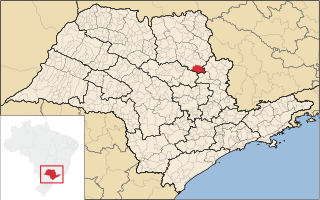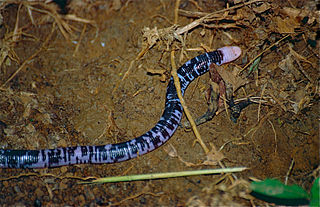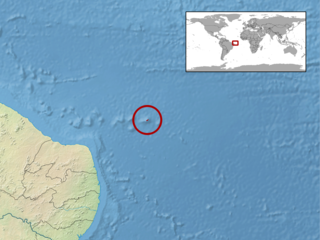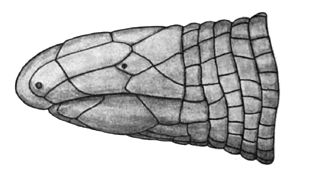
The amphisbaena is a mythological, ant-eating serpent with a head at each end. The creature is alternatively called the amphisbaina, amphisbene, amphisboena, amphisbona, amphista, amfivena, amphivena, or anphivena, and is also known as the "Mother of Ants". Its name comes from the Greek words amphis, meaning "both ways", and bainein, meaning "to go".

The island fox is a small fox species that is endemic to six of the eight Channel Islands of California. There are six subspecies, each unique to the island it lives on, reflecting its evolutionary history. They are generally docile, show little fear of humans, and are easily tamed. Island foxes played an important role in the spiritual lives of native Channel Islanders. They have been likely semi-domesticated as pets, used as pelts, or for other functions, like pest control.
Arda or ARDA may refer to:

Santa Rita do Passa Quatro is a municipality in the state of São Paulo in Brazil. Elevation is 748 metres (2,454 ft).

Amphisbaena caeca, commonly known as the Puerto Rican worm lizard or blind worm lizard, is a species of worm lizard endemic to Puerto Rico. These animals are vermicular reptiles that live under logs, rocks, and dirt. Other species of Amphisbaenids in the Caribbean include Amphisbaena bakeri, Amphisbaena fenestrata, Amphisbaena schmidti, Amphisbaena xera, and Cadea blanoides.

Heritiera littoralis, commonly known as the looking-glass mangrove or tulip mangrove, is a mangrove tree in the family Malvaceae native to coastal areas of eastern Africa, Asia, Melanesia and northern Australia. The common name refers to the silvery appearance of the underside of the leaves, resembling a mirror to some degree. The strong timber has uses in marine applications and elsewhere.

Amphisbaena fuliginosa, also known as the black-and-white worm lizard, speckled worm lizard or spotted worm lizard, is a species of amphisbaenian in the genus Amphisbaena. The ecology of A. fuliginosa is poorly known due to its fossorial habits. However, this species can be easily distinguished from others because of its characteristic white and black mosaic pattern that covers both the dorsal and ventral side.

The Butiaba naked-tailed shrew is a species of mammal in the family Soricidae. It is found in Cameroon, Central African Republic, Republic of the Congo, Democratic Republic of the Congo, Kenya, and Uganda. Its natural habitat is subtropical or tropical moist lowland forests.

Spodoptera littoralis, also referred to as the African cotton leafworm or Egyptian cotton leafworm or Mediterranean brocade, is a species of moth in the family Noctuidae. S. littoralis is found widely in Africa, Mediterranean Europe and Middle Eastern countries. It is a highly polyphagous organism that is a pest of many cultivated plants and crops. As a result, this species was assigned the label of A2 quarantine pest by the EPPO and was cautioned as a highly invasive species in the United States. The devastating impacts caused by these pests have led to the development of both biological and chemical control methods. This moth is often confused with Spodoptera litura.

Allocasuarina littoralis, commonly known as black she-oak, is a species of flowering plant in the family Casuarinaceae and is endemic to eastern Australia. It is dioecious, or less commonly a monoecious tree or shrub, that has its leaves reduced to scales, usually in whorls of six to eight, the mature fruiting cones 10–30 mm (0.39–1.18 in) long containing winged seeds (samaras) 4.0–10 mm (0.16–0.39 in) long.

Amphisbaena is a genus in the family Amphisbaenidae, commonly known as worm lizards. Over 100 species are placed in this diverse genus.

Amphisbaena alba, also known as the red worm lizard or less commonly as the white or white-bellied worm lizard, is a species of amphisbaenian in the reptilian order Squamata. Despite the large geographic range that this species covers, little is known about its ecology due to its secretive habits. A. alba has a diverse diet ranging from plant material to small vertebrates. Numerically, beetles, ants, and spiders compose the majority of their diet; however, ants, insect larvae, beetles, cockroaches, hemipterans, mole crickets, crickets, grasshoppers, termites, spiders, scorpions, pseudoscorpions, and annelids are ingested to satisfy a larger volume. The females are somewhat larger than the males, and can reach over 80 cm, which is quite large for an amphisbaenian. They are known to bury themselves in leafcutter ant nests and hide in the ants’ garbage dump areas to avoid irritating the ants into attacking, and to bury themselves to avoid predation in general.

Darwin's ringed worm lizard is a species of amphisbaenian in the family Amphisbaenidae, endemic to South America.
Vanzolini's worm lizard is a species of amphisbaenian in the family Amphisbaenidae. The species is native to northern South America.

Amphisbaena ridleyi, known by the common names Ridley's worm lizard or the Noronha worm lizard, is a species of amphisbaenian in the family Amphisbaenidae. The species is endemic to the island of Fernando de Noronha off the coast of Brazil. It is one of two indigenous reptiles on the island.
Amphisbaena xera, known commonly as the dry worm lizard, Puerto Rican dryland worm lizard, or the North American worm lizard, is a worm lizard species. It is endemic to Puerto Rico.
Baker's worm lizard is a species of worm lizard in the family Amphisbaenidae.

Amphisbaena schmidti, known commonly as Schmidt's worm lizard or the Puerto Rican dusky worm lizard, is a species of amphisbaenian in the family Amphisbaenidae. The species is endemic to the Caribbean.

Cadea is a genus of amphisbaenians, commonly known as Cuban keel-headed worm lizards, in the family Cadeidae. Two species are placed in this genus. Both species are endemic to Cuba.













